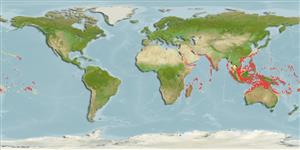Common names from other countries
Classification / Names / Names
Common names | Synonyms | Catalog of Fishes (gen., sp.) | ITIS | CoL | WoRMS
Environment: milieu / climate zone / depth range / distribution range
Ecology
Pelagic; depth range 10 - 100 m (Ref. 96667). Tropical; 33°N - 33°S, 27°E - 135°W
Indo-Pacific: Eastern Africa to Hawaii and Tahiti. Tropical and subtropical.
Length at first maturity / Size / Weight / Age
Maturity: Lm ? range ? - ? cm
Last segment of peduncle of ant. 2 in male reaches beyond eye and nearly distal margin of 1st segment of ant. 1 peduncle, in female reaches beyond middle of cornea and to distal third of 1st segment of ant. 1 peduncle; rostrum reaches proximal border of statocyst; ventral cushion of male telson much broader than its posterior height; sheath of petasma curved.
Planktonic (Ref. 75706) and coastal (Ref. 78954) species. Feeds on both phyto- and zooplanktons (Ref. 97303).
Life cycle and mating behavior
Maturity | Reproduction | Spawning | Eggs | Fecundity | Larvae
Growth from eggs to adults (7-8 mm) takes more or less 3 weeks (Ref. 97303). After fertilization, eggs remain attached to the females by short stalks to the ischia of the third pereopods until hatching (Ref. 78954).
Pérez Farfante, I. and B. Kensley. 1997. (Ref. 75620)
IUCN Red List Status (Ref. 130435)
CITES status (Ref. 108899)
Not Evaluated
Not Evaluated
Human uses
| FishSource |
Tools
More information
Age/SizeGrowthLength-weightLength-lengthMorphologyLarvaeAbundance
Internet sources
Estimates based on models
Preferred temperature
(Ref.
115969): 25 - 29, mean 28 (based on 1502 cells).
Price category
Unknown.
